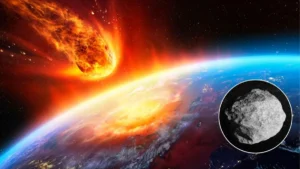While devastating forest fires are destroying cities and land areas in one part of the world, as recently in Hawaii, the sea ice continues to melt on the other side.
It seems as if the climate extremes will become more frequent this year: Although experts have predicted this development, they are still surprised by many events.
Antarctica: Ice surface as big as Mediterranean Sea is missing
According to the EU Earth observation program Copernicus, July 2023 was a good 16.95 degrees warm on a global average – and thus about 0.33 degrees hotter than the previous record July 2019 (16.63 degrees). In the Antarctic, on the other hand, new record lows are regularly measured.
A new alarming graphic has now been published on the sea ice portal, a joint project of the Alfred Wegener Institute (AWI) in cooperation with the Institute for Environmental Physics (IUP) at the University of Bremen. The mean ice extent is already more than 2.1 million km² below the long-term mean for the years 1979 to 2022. That is roughly the area of the Mediterranean Sea or six times the area of Germany, which is missing.
“There has never been anything like it”
Sea ice extent typically increases when the Arctic summer ends, which is in February. But this time the area covered is significantly smaller than the average over the past 40 years.
Experts fear that this missing ice could have a significant impact on the global climate.
“There has never been anything like this since we have satellites,” said Christian Haas, head of the Sea Ice Physics section at the Alfred Wegener Institute (AWI), to the German Press Agency. So far, the sea ice surface has recovered again and again in the Antarctic winter. The current situation could have far-reaching consequences.
Haas: “The question is whether it’s the beginning of the end of the sea ice in Antarctica. If things continue like this, there will be no more sea ice in the summer.”
The consequences would be serious, because the ice on the oceans influences the earth’s radiation budget, ocean currents, the weather and the climate. It is also a habitat for numerous species – from tiny microorganisms to fish, penguins and whales.
Antarctica: Important circulation pump is already sputtering
The oceans play a key role in determining how the sun’s energy is distributed on earth: If there is no white sea ice, for example, which reflects the light back into space, the dark ocean absorbs solar energy and continues to warm up. More ice melts and the whole process is amplified.
This in turn has a significant influence on ocean currents, i.e. on how water masses in the oceans move over the earth. There is evidence that the Antarctic overturning circulation, which regulates Earth’s climate, is already slowing. Cold, oxygen-rich water shoots from the continent’s shelf into the deep sea and is considered one of the major engines of global ocean currents.
Circulation has already slowed by a third
But this engine appears to be sputtering menacingly, as a research team recently found out. Accordingly, the circulation in the region has already slowed down by a third. This would mean that the decline would be much earlier and perhaps even stronger than previously feared. This “circulation pump” acts like the earth’s lungs. They transport heat, carbon, oxygen, and nutrients around the globe—a process that affects climate, sea levels, and more.
The study also shows that this overturning circulation in Antarctica will slow by more than 40 percent over the next 30 years unless global carbon emissions change. The major currents would gradually collapse. Such a collapse would affect global climate and marine ecosystems for centuries to come.
Von Martin Gätke (mg)
Source: https://www.focus.de/earth/ist-vielleicht-der-anfang-vom-ende-neue-grafik-zeigt-alarmierende-entwicklung-fuer-unsere-erde_id_201911490.html


